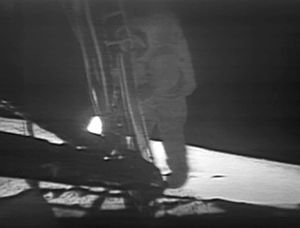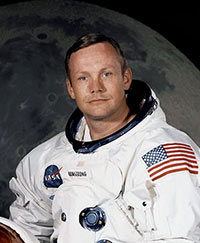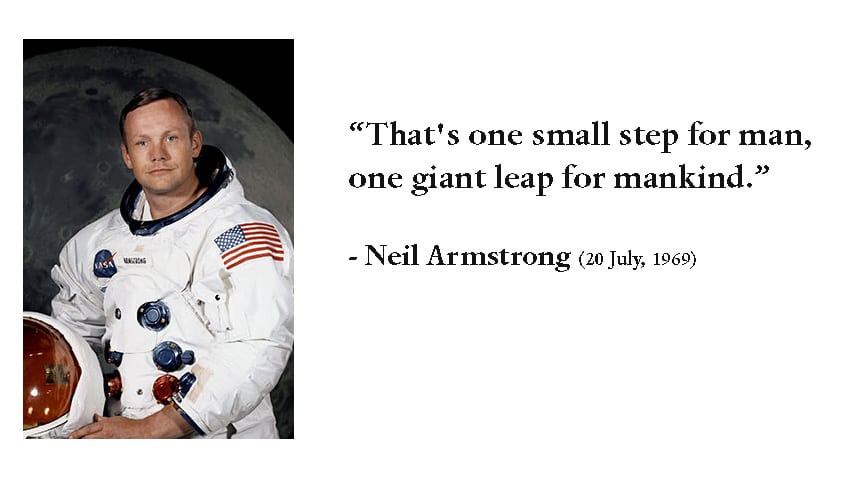In 1969, the lunar landings transfixed the whole globe. Previously the idea of landing on the moon had been the stuff of science fiction. But, in a seeming short space of time, man had enabled huge strides in technology which enabled the seemingly impossible to become reality. It is regularly cited as a great moment that changed the world.
But, what was the significance of the lunar landings?
1. Self-Transcendence
Neil Armstrong – the first person to walk on the moon. Also with his colleagues Buzz Aldrin and Michael Collins, the first person to land a craft on the moon. In 1969, Armstrong was asked about the lunar landings. He replied that it was part of man’s expression for self-discovery.
“I think we’re going to the moon because it’s in the nature of the human being to face challenges. It’s by the nature of his deep inner soul … we’re required to do these things just as salmon swim upstream.”
In the early Twentieth Century, man’s taste for challenge and exploration was found in explorations to the north and south pole – attempts to climb the highest peaks of the world. By the 1960s, we had reached all corners of the globe, including the highest and farthest. The final frontier was to see life beyond the earth.
2. Cold-War Symbolism
There is no doubt that part of the motivation and funding for the space programme came from national pride. There was a strong rivalry between the Communist Soviet Union and the United States. The Soviet Union seemed to have the upper hand in the space race, when they put the first man in space – Yuri Gagarin, 1961. The race to land on the moon was one that the US wanted to win.
However, Neil Armstrong put an interesting perspective on this ‘space race’
“I’ll not assert that it was a diversion which prevented a war, but nevertheless, it was a diversion.”
- Apollo 11 40th anniversary celebration (2009)
Like sport, the space race was a global competition, which spurred technological progress. But, the space race was also a rare case where there was a mutual respect between the two countries – or at least between fellow astronauts.
The Apollo 11 mission commemorating the achievements of Yuri Gagarin and fellow cosmonaut Vladimir Komarov – by leaving medals dedicated to them on the surface of the Moon. In 1970, Neil Armstrong visited the Soviet Union and was warmly received. Russian Cosmonaut Valentina Tereshkova presented Neil Armstrong (1930-2012) with a badge in memory of his visit to the Gagarin Cosmonaut Training Center in Moscow, Russia.
Pride for America
There is no doubt that the moon landing was a proud moment for America. In particular, it was a positive ending for a turbulent decade. A decade that had seen the civil rights protests, the Vietnam War and the assassination of major political leaders – John F. Kennedy, Martin Luther King and Robert Kennedy.
Was the moon landing worth it?

In the 1960s, as now, there was widespread economic and social problems on earth. The US, the richest country in the world, still had wide-scale poverty – and lingering problems from decades of racial segregation and the resultant poverty. During the moon landings, there were civil rights protests, protests who argued that the billions spent on the space programme, could have been better spent dealing with problems closer to home.
Another interesting feature about the moon landings is that although it promised a whole new adventure, the program fizzled out. In 1972, Eugene Cernan, also walked on the moon. But, he is the last person to have done it, and by then interest had waned. Far from leading to moon stations, very little direct benefit has been attained from walking on the moon.
Citation: Pettinger, Tejvan. “Significance of the Moon Landings”, Oxford, UK. www.biographyonline.net Published 2 Feb 2015. Last updated 15 February 2018.
Related pages

Events that changed the world – Russian Revolution, the Atom Bomb, the Moon Landings.
Neil Armstrong
Biography of the first man to walk on the moon


2 Comments
In spite of what you are thinking, there really are serious reasons to believe that the moon landings were not real, and it’s much more than about the usual arguments.
The ascent module was conceived in an asymmetrical way; the oxidizer tank was placed closer to the ascent engine than the fuel tank which was excentered; the official reason was that the oxidizer had a greater density than the fuel; but the problem with this disposition is that, as the ascent engine was burning propellant, the center of mass was shifting (toward the fuel tank), causing an increasing misalignment torque; as the ascent engine was not gimballed (unlike the descent engine), it could not be swivelled to remake the alignment of the line of thrust with the center of mass; the consequence is that this misalignment torque could only be corrected with the lateral thrusters (RCS): the problem is that these lateral thrusters could not be throttled, and thence could not apply a counter torque which would have been equivalent to the misalignment torque; the result was an increasing swaying move of the lunar module (which can be seen in the video of the ascent of Apollo 17).
Furthermore, the logical command interface of the lateral thrusters shows inexcusable problems, like vertical commands (roll and pitch) activating two vertical thrusters directly opposed to each other! How could it work if both thrusters were pushing in opposite directions?
It would have been possible to make things more rationally, by using two oxidizer tanks and two fuel tanks placed symmetrically relatively to the ascent engine (like it was made in the descent module).
And I have seen an incredible number of errors in the electronic interfaces of the lunar module, which obviously were intentional.
And it is not true that the astronauts could take a trajectory which would avoid the most dangerous part of the Van Allen belts, for it would have meant burning too much fuel, more than what the spaceship could afford.
And it is not true either that the astronauts were safe after having passed the Van Allen belts, for there is no more protection against radiations (caused by solar eruptions) after having passed these belts.
And it is not true that the space suit of the astronauts would have allowed them to survive in the very hard conditions of the moon for the whole duration of their EVA.
It is not true that it is easy to land on the moon; it is more difficult to land on a planet without an atmosphere than on a planet with an atmosphere, because, on a planet without an atmosphere, everything must be done actively (it is not possible to use a parachute for instance, and to use the force of air to brake).
Not counting that, on the videos, I see spaceships which break the laws of physics, by changing their orbital speed in a impossible way, or by making impossible exaggerated rotations on the powered descent or the powered ascent; in the powered descent and powered ascent, the change of pitch can only be slow and regular, never brutal.
Agreed! First lunar landing is one of the biggest achievement for Neil Armstrong and United States.